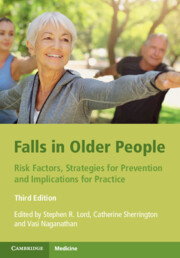43 results
28 - Strategies to Promote Uptake and Adherence to Fall Prevention Programmes
- from Part III - Implications for Practice
-
-
- Book:
- Falls in Older People
- Published online:
- 04 November 2021
- Print publication:
- 04 November 2021, pp 427-435
-
- Chapter
- Export citation
Contributors
-
- Book:
- Falls in Older People
- Published online:
- 04 November 2021
- Print publication:
- 04 November 2021, pp xiii-xvi
-
- Chapter
- Export citation
Part I - Epidemiology and Risk Factors for Falls
-
- Book:
- Falls in Older People
- Published online:
- 04 November 2021
- Print publication:
- 04 November 2021, pp 1-248
-
- Chapter
- Export citation
Preface
-
- Book:
- Falls in Older People
- Published online:
- 04 November 2021
- Print publication:
- 04 November 2021, pp ix-xii
-
- Chapter
- Export citation
31 - Bringing It All Together
- from Part III - Implications for Practice
-
-
- Book:
- Falls in Older People
- Published online:
- 04 November 2021
- Print publication:
- 04 November 2021, pp 469-480
-
- Chapter
- Export citation
15 - The Relative Importance of Fall Risk Factors: Analysis and Summary
- from Part I - Epidemiology and Risk Factors for Falls
-
-
- Book:
- Falls in Older People
- Published online:
- 04 November 2021
- Print publication:
- 04 November 2021, pp 237-248
-
- Chapter
- Export citation
Copyright page
-
- Book:
- Falls in Older People
- Published online:
- 04 November 2021
- Print publication:
- 04 November 2021, pp iv-iv
-
- Chapter
- Export citation
Part II - Strategies for Prevention
-
- Book:
- Falls in Older People
- Published online:
- 04 November 2021
- Print publication:
- 04 November 2021, pp 249-424
-
- Chapter
- Export citation

Falls in Older People
- Risk Factors, Strategies for Prevention and Implications for Practice
-
- Published online:
- 04 November 2021
- Print publication:
- 04 November 2021
Part III - Implications for Practice
-
- Book:
- Falls in Older People
- Published online:
- 04 November 2021
- Print publication:
- 04 November 2021, pp 425-480
-
- Chapter
- Export citation
Index
-
- Book:
- Falls in Older People
- Published online:
- 04 November 2021
- Print publication:
- 04 November 2021, pp 481-488
-
- Chapter
- Export citation
1 - Epidemiology of Falls and Fall-Related Injuries
- from Part I - Epidemiology and Risk Factors for Falls
-
-
- Book:
- Falls in Older People
- Published online:
- 04 November 2021
- Print publication:
- 04 November 2021, pp 3-22
-
- Chapter
- Export citation
Contents
-
- Book:
- Falls in Older People
- Published online:
- 04 November 2021
- Print publication:
- 04 November 2021, pp v-viii
-
- Chapter
- Export citation
16 - Exercise to Prevent Falls
- from Part II - Strategies for Prevention
-
-
- Book:
- Falls in Older People
- Published online:
- 04 November 2021
- Print publication:
- 04 November 2021, pp 251-270
-
- Chapter
- Export citation
Chapter 8 - Gait impairment and falls
- from Section II - Geriatric syndromes
-
-
- Book:
- Reichel's Care of the Elderly
- Published online:
- 05 June 2016
- Print publication:
- 23 June 2016, pp 107-115
-
- Chapter
- Export citation
The Extent and Quality of Evidence in Neurological Physiotherapy: An Analysis of the Physiotherapy Evidence Database (PEDro)
-
- Journal:
- Brain Impairment / Volume 1 / Issue 2 / 01 October 2000
- Published online by Cambridge University Press:
- 21 February 2012, pp. 130-140
-
- Article
- Export citation
7 - Medications as risk factors for falls
-
- Book:
- Falls in Older People
- Published online:
- 03 May 2010
- Print publication:
- 01 March 2007, pp 133-150
-
- Chapter
- Export citation
13 - Assistive devices and falls prevention
-
- Book:
- Falls in Older People
- Published online:
- 03 May 2010
- Print publication:
- 01 March 2007, pp 264-299
-
- Chapter
- Export citation
11 - Exercise interventions to improve physical functioning
-
- Book:
- Falls in Older People
- Published online:
- 03 May 2010
- Print publication:
- 01 March 2007, pp 204-239
-
- Chapter
- Export citation
15 - Prevention of falls in hospitals and residential aged care facilities
-
- Book:
- Falls in Older People
- Published online:
- 03 May 2010
- Print publication:
- 01 March 2007, pp 311-332
-
- Chapter
- Export citation



